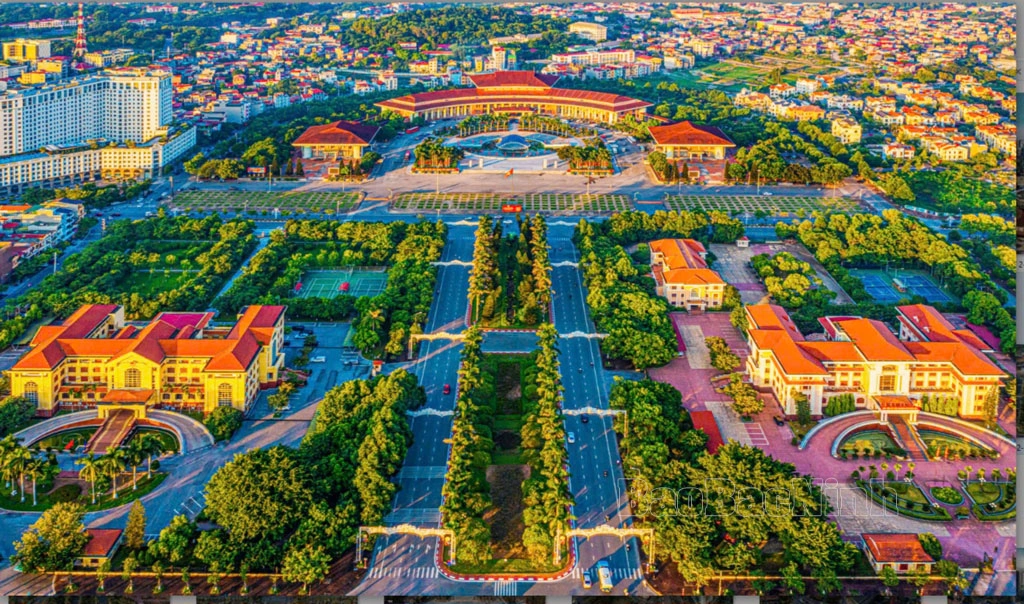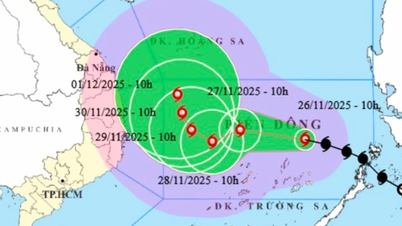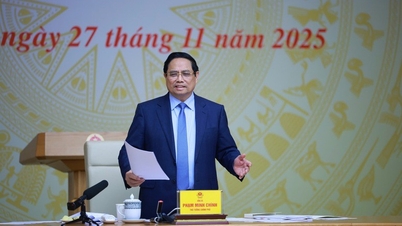Associate Professor Dr. Bui Hoai Son, National Assembly Delegate, Standing Member of the National Assembly's Committee on Culture and Education , spoke with Dan Tri reporter about the Politburo and Secretariat's request to study the orientation of merging a number of provinces, which is receiving great attention from public opinion.
Why is public opinion agree?
The Politburo and Secretariat's request to study the merger of some provincial administrative units has received great public attention in recent days. Can you explain the main reasons for such public support?
- I think there are many important reasons. One of the main reasons is the need to improve the effectiveness and efficiency of the administrative apparatus. Streamlining administrative units helps reduce intermediate levels, thereby minimizing overlap, bureaucracy and increasing the speed of work processing. Thereby serving people and businesses more quickly and effectively.
When the machine operates smoothly, without unnecessary intermediaries, resources will also be allocated more reasonably, creating momentum for socio-economic development.
Another important reason for public approval is the desire to save budget and focus investment on essential areas. When merging administrative units, the cumbersome apparatus is streamlined, which means reducing operating costs, reducing the number of administrative agencies, reducing staff, thereby saving a significant part of the state budget.
This budget can be reinvested in important areas such as health care, education, infrastructure, social security, etc., contributing to improving people's quality of life.
National Assembly Delegate Bui Hoai Son (Photo: Pham Thang).
Another factor that makes public opinion support is the expectation of planning and developing localities in a sustainable, synchronous and long-term vision. Currently, there are provinces and cities with small populations and limited resources, making it difficult for them to develop strongly in the context of competition and integration.
When localities are merged together on a reasonable basis, they can make the most of their geographical, resource and infrastructure advantages, thereby forming large economic and cultural centers with stronger influence in the region and the whole country.
Public opinion is interested and supportive because this is a major, strategic decision, demonstrating innovation in national governance thinking. The reorganization of administrative units is not simply a change in boundaries but a profound reform in the way the apparatus is organized, the way the administration is managed and operated, aiming for greater professionalism, efficiency and modernity.
This is completely consistent with the world development trend, when many countries have also carried out similar administrative reforms to enhance governance efficiency.
With such obvious benefits, public interest and consensus for this policy is completely understandable.
However, to achieve the highest efficiency in the merger, careful research, a reasonable implementation roadmap and especially listening to opinions from local authorities, experts and people are needed to ensure high consensus in the whole society.
Bac Ninh is the smallest province in Vietnam with an area of 822.70 square kilometers; population of nearly 1.5 million people, ranked 22nd in Vietnam's population rankings (Photo: Bac Ninh Newspaper).
According to you, what specific criteria and conditions should be used to study the merger of provinces? What practical experiences should be applied in the past when merging administrative units at district and commune levels?
- The study of merging provinces must be based on specific criteria and conditions to ensure effectiveness, rationality and suitability to reality. First of all, I see that the most important factors are population size and natural area. A province with too small a population or too small an area may face many limitations in socio-economic development, while a province that is too large may cause difficulties in management.
Therefore, it is necessary to calculate a reasonable scale, ensuring a balance between population, area and management capacity.
The merged provinces need to have similarities or complement each other in terms of economic structure, development level, and per capita income to avoid large differences, causing difficulties in management and resource allocation.
If one province has a strong economy while the other province still has many difficulties, the merger needs a clear roadmap to ensure harmony and not create inadequacies in policies and development opportunities.
In addition, cultural - historical - social factors are also extremely important. The merger needs to consider the similarities in cultural traditions, customs, and regional identities to ensure cohesion in the community, avoiding differences that may lead to difficulties in management and operation. If the two provinces have too great a difference in culture and society, the integration process may encounter obstacles, affecting stability and long-term development.
Geographical factors and traffic infrastructure also need to be carefully calculated. The merged provinces should have convenient traffic connections, not be separated by complex terrain factors such as mountains, rivers or too far geographical distance, to ensure smooth management and operation. At the same time, the merger also needs to take into account the ability to develop new urban systems and administrative centers in a reasonable and convenient way for people and businesses.
The merger research process needs to refer to practical experiences that have been implemented in merging administrative units at district and commune levels. In fact, there are localities that have successfully implemented it, bringing positive effects on management, budget savings, and improving the quality of public services. However, there are also places that face difficulties due to differences in development levels, cultural differences, or problems in determining new administrative centers.
These lessons are very important to help us have a systematic provincial merger plan, avoiding unnecessary mistakes.
Pilot first, expand later; 45-50 provinces and cities is appropriate.
A survey by Dan Tri Newspaper shows that currently, many provinces and cities across the country do not meet the criteria on population, natural area and district-level administrative units as prescribed in Resolution No. 1211/2016 and Resolution No. 27/2022 of the National Assembly Standing Committee on standards of administrative units and classification of administrative units. In your opinion, these localities should be put in the "sights" for immediate consideration of merger?
- The fact that many provinces and cities do not meet the criteria on population, natural area and district-level administrative units is a worrying reality. This requires careful consideration and assessment to have a reasonable merger roadmap.
I think that localities with too small a population or too limited an area should be considered for merger first. This will not only help improve the efficiency of administrative management, but also create conditions for these localities to have more resources for development, avoiding the situation of a cumbersome apparatus but low operational efficiency.
When a province has a small population, limited budget revenue, and difficulty attracting investment, maintaining a separate administrative management apparatus will waste resources. Therefore, merging with neighboring provinces with similar conditions will help optimize the apparatus, save budget and improve competitiveness.
With a population of 0.32 million, a natural area of 4,859.96 km2 and only 8 district-level administrative units, Bac Kan province does not meet all 3 standards for provincial-level administrative units according to the National Assembly's resolution (Source: BacKan.gov.vn).
In addition, localities with too few district-level administrative units should also be considered for merger to ensure the rationality of the organizational model. A province with too few districts may have difficulty maintaining and developing planning policies, socio-economic infrastructure, as well as making full use of regional advantages.
However, the merger cannot be based solely on rigid criteria of population and area, but must take into account other practical factors such as similarities in culture, history, socio-economic development conditions, and transport infrastructure connections. Provinces with large differences in these factors should be carefully considered before being included in the merger.
The merger review process also requires extensive consultation from all levels of government, experts and especially the people. After all, the goal of the merger is to improve the quality of management and serve the people better, so social consensus is the key factor.
In 1976, the whole country had only 38 provinces and cities. After many mergers and separations, from 2008 to now, Vietnam has 63 provinces and cities. In your opinion, how many provinces and cities should our country have?
- The number of provinces and cities should be determined based on scientific and practical criteria, instead of simply a fixed number. However, if we consider population size, area, management capacity and socio-economic development, I think that Vietnam can be reduced to about 45-50 provinces and cities for sustainable development.
Maintaining 63 provinces and cities with a cumbersome administrative apparatus is creating a lot of pressure on budget, staffing and operational efficiency. Meanwhile, many provinces have low population size, small area, limited economic capacity, leading to a situation where resources are dispersed, making it difficult to promote advantages.
If merged properly, larger provinces will have the conditions to build stronger development strategies, attract better investment and improve the quality of state management.
If we reduce the number of provinces, but improve the quality of management, strongly apply digital technology, and reform administrative procedures, the state apparatus will operate more effectively.
The models of some countries with similar conditions to Vietnam can be a reference lesson for us. For example, South Korea has a population of over 50 million but only 17 provinces/cities, or China has nearly 1.4 billion people but only 34 provincial-level administrative units. Compared to these countries, the number of 63 provinces and cities in Vietnam is high, causing resource dispersion and difficulties in macro management.
Therefore, the number of about 45-50 provinces and cities is reasonable in my opinion. The merger process needs to be carried out scientifically, with a clear roadmap. Most importantly, there must be consensus from the people, so that the merger is not just an administrative decision, but really brings long-term benefits to the country.
Merging provinces is expected to open up more development space for localities. What is the appropriate roadmap for this when the whole country will soon hold party congresses at all levels?
- Obviously, the provincial merger roadmap needs to be carefully calculated to ensure stability, consensus and not disrupt local socio-economic management and development activities, especially when we are moving towards Party Congresses at all levels.
First of all, I find that this process needs to be done in specific stages, with careful steps, not hasty.
The merger should be implemented according to the principle of "piloting first, then expanding later". Some provinces with small scale and more favorable merger potential can be selected as pilot models to gain experience and adjust policies before implementing widely. During this time, local authorities need to stabilize the organization, clearly define personnel plans, functions and tasks, and avoid major disruptions in the operation process.
In addition, I think that the provincial merger cannot be separated from the preparation process for the Party Congresses at all levels. Therefore, the roadmap needs to be designed to fit this important political cycle.
For now, we can focus on completing the research, developing the project and gathering public opinions this year. If agreed, the merger can begin after the Party Congress, when the new leadership has been completed and there is enough time to implement the next steps.
The merger is not only a change in administrative boundaries but also affects a series of issues related to state management, budget, infrastructure and people's lives. Therefore, there is a need for support mechanisms and specific policies to help localities after the merger quickly stabilize, promote advantages and avoid interruption in development.
If done well, this will be a great opportunity for our country to optimize the administrative apparatus, improve governance efficiency and create stronger development space for localities.
Thank you!
National Assembly Delegate: It is appropriate to maintain only 40 provinces and cities.
National Assembly delegate Pham Van Hoa (Dong Thap) said the issue of merging provinces with small populations and areas was brought to the National Assembly 5-6 years ago. With a population of over 100 million people, having 63 provinces and cities, according to Mr. Hoa, is too many.
"China has a population of more than 1.4 billion people but only has 34 provincial-level administrative units (including 23 provinces, 5 autonomous regions, 4 centrally-run cities and 2 special administrative regions). Vietnam has separated and merged provinces many times for development, but I think it is still not thorough," Mr. Hoa said, adding that it is appropriate to maintain only about 40 provincial-level administrative units.
The transport infrastructure system is strongly developing, and communication is also complete and smooth, so it can ensure the management of large areas and large populations.
In addition to population size and natural area, Mr. Hoa said that it is necessary to take into account criteria on culture, history, national security, sovereignty protection, geopolitical position, culture of the community... when considering merging provinces to ensure stability for socio-economic development.
Dantri.com.vn
Source: https://dantri.com.vn/xa-hoi/viet-nam-chi-nen-duy-tri-45-50-tinh-thanh-20250224220741967.htm







![[Photo] President Luong Cuong attends the 50th Anniversary of Laos National Day](/_next/image?url=https%3A%2F%2Fvphoto.vietnam.vn%2Fthumb%2F1200x675%2Fvietnam%2Fresource%2FIMAGE%2F2025%2F11%2F27%2F1764225638930_ndo_br_1-jpg.webp&w=3840&q=75)



![[Photo] Prime Minister Pham Minh Chinh chairs the 15th meeting of the Central Emulation and Reward Council](/_next/image?url=https%3A%2F%2Fvphoto.vietnam.vn%2Fthumb%2F1200x675%2Fvietnam%2Fresource%2FIMAGE%2F2025%2F11%2F27%2F1764245150205_dsc-1922-jpg.webp&w=3840&q=75)

































































































Comment (0)